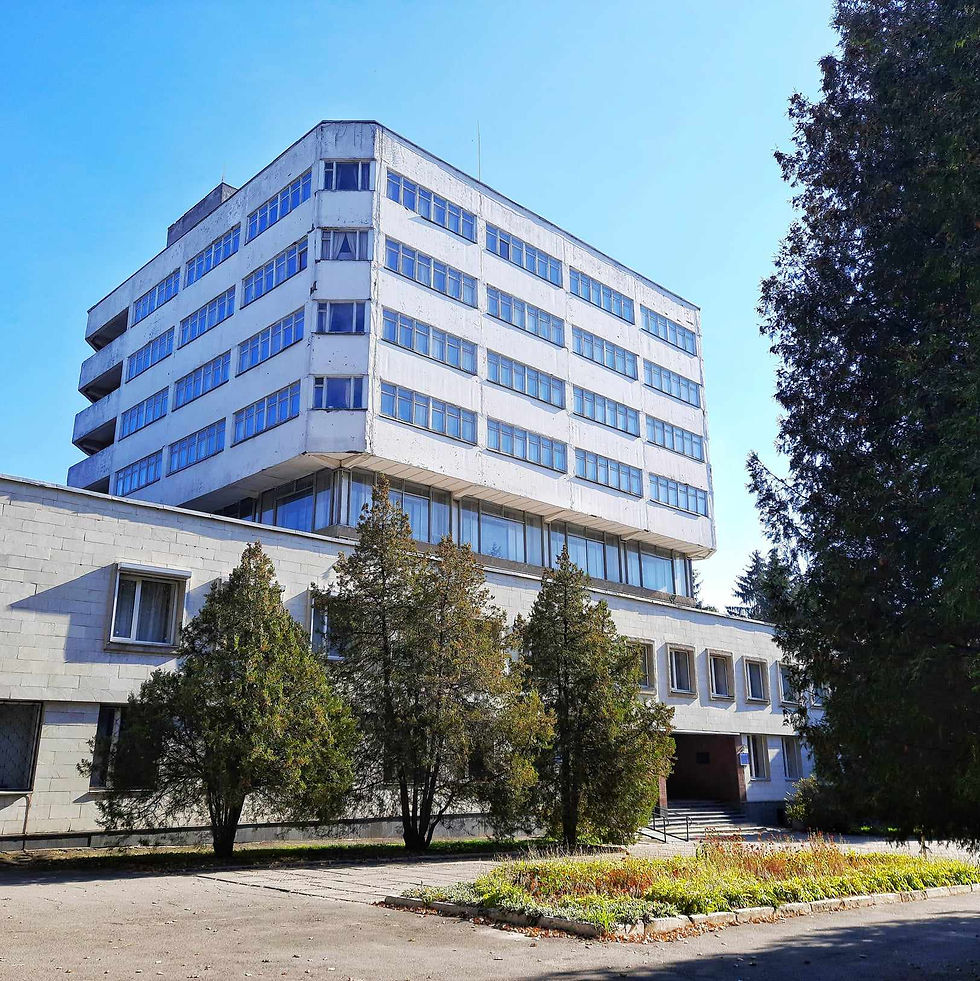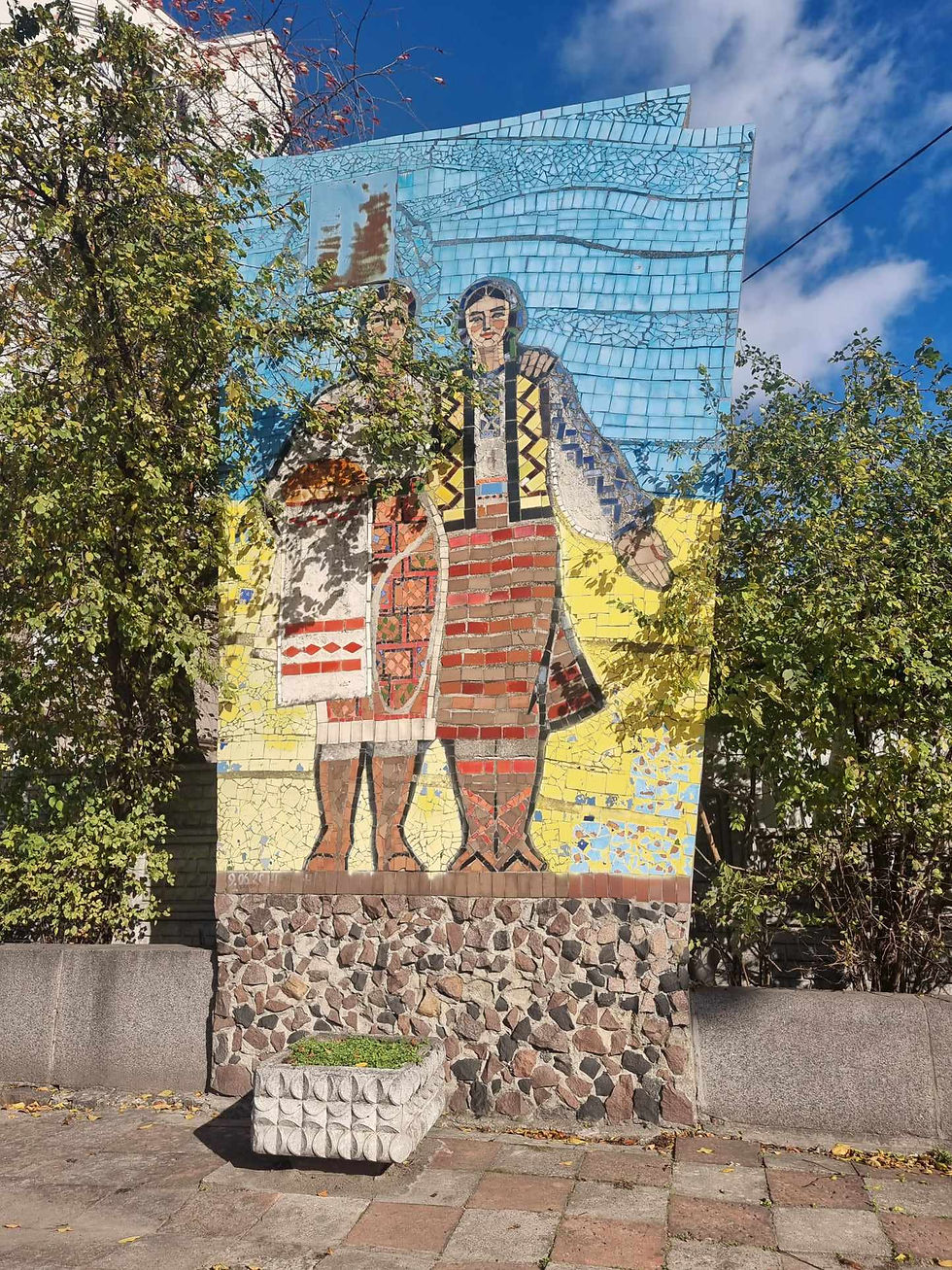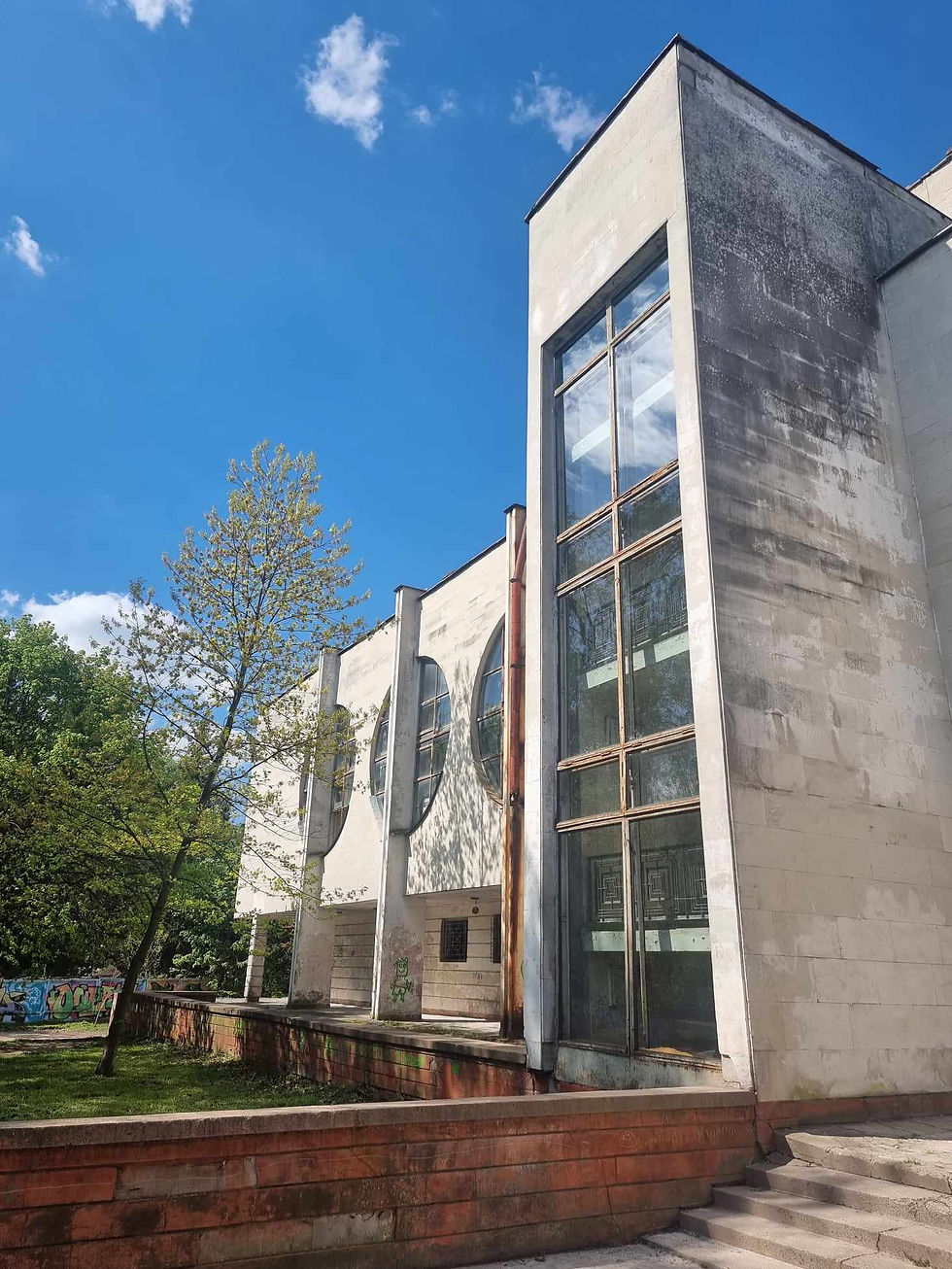Soviet Modernism in War-Torn Ukraine
An Interview with Ukrainian Photographer Volodymyr from Futuristic_Modernism
Ukraine was the second most populous republic in the Soviet Union. Its primacy within the Soviet system put it at the forefront of a wide array of architectural and artistic developments such as Constructivism, Socialist Realism, Socialist Modernism, Soviet monumental public art, and even Soviet Postmodernism. As a result, the country found itself gifted with an extensive architectural legacy already controversial enough in less troubled time, but even more so after the ill-fated invasion of Ukraine by Russia led a society under strain to reconsider the value of everything even remotely associated with Russia and the Soviet past. Yet the ongoing war has not deterred some courageous photographers to keep documenting the Soviet heritage of Ukraine. Volodymyr is one of them. He kindly agreed to answer some questions about the current state of Soviet modernism in Ukraine, the extent and varying causes behind the destruction of Soviet-era buildings and artworks, as well as the reality of being a photographer in a country at war.
Hello! Please introduce yourself to our readers.
My name is Volodymyr. I have a background in history, specializing in antiquity, but ironically, for the past few years, I have been actively studying architectural modernism — a movement that deviates significantly from classicism and antiquity. I frequently travel and capture photographs of modernist masterpieces. Recently, I created an Instagram account called "futuristic_modernism" where I share these photos. However, since February 24th, my life has undergone significant changes. Due to the war, I am unable to travel abroad, so I have shifted my focus to exploring more of Ukraine. I have been venturing into lesser-known places in search of Soviet monumental art and architecture in the "SovMod" style.

Photo: futuristic_modernism
How was Soviet architecture and public art perceived in Ukraine before the war?
The perception of Soviet heritage in Ukraine prior to the war varied greatly depending on the region and age group. In western Ukraine, the general attitude towards the USSR was generally more negative compared to residents of the central and southeastern parts of the country. However, it is an oversimplification to assume that everything Soviet was demolished in the west and preserved in the east of Ukraine, or that older people staunchly defend “SovMod” buildings while younger generations dream of demolishing the iconic Salute Hotel (one of Kyiv’s most recognizable Soviet buildings). In reality, the majority of the population simply didn't pay much attention to modernist architecture and art, whether it was Soviet or Polish functionalism from the interwar period. I often encountered situations where I would visit a city, start photographing a modernist building and its interior, and locals would approach me without understanding why I found it worthy of capturing. It wasn't that they opposed it, they simply didn't see any value in that particular piece of architecture, sometimes questioning, "What's so special about it?" Unfortunately, I have observed a similar attitude towards modernist architecture in other countries as well, so Ukrainians are not unique in this regard.
It is precisely this dismissive and indifferent attitude that has allowed for the destruction of a significant number of modernist buildings and monumental art objects without much public resistance. They have been replaced by hideous shopping centers made from low-quality materials. Corrupt officials willingly assist businessmen in illegally destroying architectural landmarks in exchange for bribes. These individuals are driven solely by profit and lack any ideological or aesthetic purpose. Occasionally, a self-absorbed oligarch wants to leave their personal mark on a project, resulting in the replacement of graceful modernist buildings with kitschy monstrosities, much to the delight of the general public. In many cases, modernist buildings that are still used by the government, such as schools or administrative offices, undergo "reconstruction" by officials to make them more appealing to the public. Unfortunately, this often involves altering them beyond recognition, disregarding the original architect's design. The doors and windows are replaced with cheap white plastic ones, and tasteless paint jobs or plastic rainscreens cover the walls.
The emergence of the argument of ideological incorrectness of Soviet modernism occurred in Ukraine after 2014, following a change in power resulting from protests. As part of the new ideology, there was a deliberate contempt for everything associated with the USSR. However, as part of the cultural policy, only a small fraction of monuments dedicated to the most controversial historical figures responsible for Stalinist repressions were demolished by state representatives. This also included most of the ubiquitous Lenin statues across our post-Soviet country. Modernist buildings were not directly affected by the new laws, but the process of decommunization brought attention to the extent of Soviet influence in people's surroundings. Prior to that, there were individual enthusiasts expressing their love or hate for socialist creations, but during this period, a genuine public discussion began regarding the aesthetic value of Soviet art and architecture and their ideological foundations. Organizations dedicated to the preservation of monumental art emerged, bloggers started discussing the value of modernism, and some individuals even took it upon themselves to repair Soviet bus stops in rural areas. However, there were also cases where activists on the other side of the debate complained about Soviet symbols on certain mosaics, leading to their demolition. Of course, those advocating for demolition were predominantly on the winning side. However, it's important to note that these debates involved a few hundred people on each side — those wanting to save modernist buildings and those wanting to demolish them. The general public still showed little interest, apart from the common misconception that Soviet-era prefabricated residential buildings, known as "panelkas," were all grim, dull, and indistinguishable.
Ironically, the anti-Soviet discourse among urbanists and activists who support a nationalist agenda has rarely criticized Stalinist neoclassical architectural style. The central part of Kyiv, including its government district, was constructed in this style, which these same people admire. Therefore, it is not the "Sovietness" that bothers them. The most common critical argument against modernist architecture in Ukraine is that it represents totalitarian ideas, even though the beloved Khreshchatyk Boulevard was built during the most oppressive totalitarian period in our history.
How has the war impacted this perception?
Once the military situation stabilized, a new cultural policy and a new wave of social thought emerged. The simple dislike of Soviet heritage was replaced by a genuine anti-colonial discourse. Unfortunately, Ukraine has not followed the path of most other post-colonial countries, which generally treat the material heritage of the previous era positively or at least indifferently. In addition to the common perception of architectural modernism as something incomprehensible and ugly, which is prevalent in many countries, there is also the belief that such buildings, especially monumental art, symbolize the dominance of Soviet (and therefore Russian) imperialism. While there hasn't been purposeful and systematic destruction of modernist buildings, it has become much more challenging to preserve the original appearance of SovMod during chaotic construction and "renovation" processes. The situation is even more difficult with Soviet mosaics, sculptures, and murals. While modernist buildings may appear relatively "neutral" without overtly expressing any Soviet messages through their visuals, monumental art often directly references Soviet narratives. Even if some of these narratives are positive, they are now perceived as dangerous clichés by a significant portion of Ukrainian society. For example, the idea of friendship among peoples is now seen by many as passive reconciliation with the occupier. Anything related to the Soviet army and how Ukrainians welcomed Soviet soldiers "with bread and salt" (sometimes literally depicted in mosaics, like at Ternopil) is viewed even more negatively.
This trend has allowed city mayors, school principals, and various government employees to gain favor without much effort. Instead of focusing on developing infrastructures, improving education, and performing their duties efficiently, they can simply destroy a Soviet mosaic and continue with corrupt practices, bribery, and complacency. A recent and extreme case occurred in the city of Rivne, where the mayor used a hammer to destroy a mosaic depicting two Ukrainian women, falsely claiming that one of them was Russian. There was no research, no expert opinions, no voting — simply an arbitrary act. In reality, the mosaic represented the unity of Eastern and Western Ukraine, with both women dressed in traditional regional costumes. Unfortunately, when someone now stands up for Soviet architecture and art, they can instantly be labeled on social media platforms as pro-Russian collaborators or "sovok" (a derogatory term referring to someone who loves the USSR, the word sounds the same in Russian/Ukrainian as dustpan). That's cancel culture with an Ukrainian flavor.

The mosaic in Rivne that was destroyed on the false assumption that it represented a Russian woman.
Photo: futuristic_modernism
However, it's not all bleak. There are still people who understand that architecture is not synonymous with the regime in which it was built. Besides, the overall indifference of the masses remains difficult to overcome. Paradoxically, this indifference may now work in favor of those defending Soviet heritage. In many lesser-known places in Ukraine, you can still find mosaics featuring the hammer and sickle or a Red Army soldier. That's precisely why Ukrainian instabloggers who photograph socialist art and architecture rarely disclose the location of the objects in their photos, even if asked privately. It's better if the location remains unknown to the general public and the locals don't notice it out of ignorance. As the saying goes, never ask a Galician how his grandfather obtained his Mauser or ask a school principal about the man with a red star on his cap depicted in the school's hall. Once noticed, these objects are likely to be demolished or altered.
Surprisingly, the most significant reevaluation of modernist architecture and monumental art has taken place in Lviv, a city traditionally known for its deep-rooted hatred of the USSR. This shift can be attributed, in part, to the increased dialogue between authorities and residents and the advanced urbanism experience that Lviv represents for Ukraine. This experience has taught both the authorities and citizens to appreciate all types of architectural objects. Additionally, there is a strong belief among the townsfolk that no mosaic or building can alter the local consensus regarding the Soviet past and communist ideology. The presence of numerous masterpieces of Polish functionalism and art-deco in Lviv, towards which there has never been hostility, also contributes to this perspective.
An example of this attitude can be seen in the renovation of the long-abandoned Lorta House of Culture, which now serves as temporary housing for refugees and a public space. While the exterior of the building has not been restored, the fact that the interior has been repaired and the beautiful mosaic in the hall has been preserved is a significant achievement. In this case, it's actually beneficial that the facade hasn't been renovated because, unfortunately, Ukraine has a poor track record in properly executing such restorations.

Photo: futuristic_modernism
How difficult is it to keep taking pictures in the middle of the war?
There are several official rules regarding what cannot be photographed. The list of prohibitions includes military facilities and equipment, anti-aircraft defense operations, missile launches and enemy missile impact sites. So, technically there is no restriction on taking photos even of the government central offices or metro stations but it's all up to common sense. You definitely shouldn't take pictures of the Security Service of Ukraine's office building, you will get in trouble and it is generally not a good idea. But if it's something like a district administrative office of civil service, it's totally fine. At least that's how it should work. In reality, people can prevent you from taking photos in almost any location.
The biggest problem arises precisely with photographing modernist architecture. Referring back to what I mentioned earlier, the majority of people do not understand the value of modernist buildings and do not even notice them. They think that if you are photographing an object that is not clearly "beautiful", it must be to target it with missiles because why else would you photograph it. It often reaches absurdity. For example, in Khmelnytskyi, I wanted to take photos of the interior of the market building, but local babushkas shouted at me and wanted to call the police. I never understood why anyone would target a missile at a market in Khmelnytskyi, but unfortunately, such a reaction is normal. This spymania is a peculiar magical thinking of the masses. People see news on the internet about Russians hitting homes and shopping centers with missiles, and they think that someone's photographs are causing these missiles, as if it is some kind of spell, even though all these buildings are on Google Maps anyway.
The further away from the front line, the more paranoid people become. I was in Chernihiv and Mykolaiv, cities that were heavily affected by Russian missiles, and I didn't have any problems at all. I photographed literally everything I wanted, except for buildings that my common sense told me not to photograph. Meanwhile, in the Ivano-Frankivsk region, I was stopped, reprimanded, and asked to delete a photograph three times. In Zakarpattia, right on the border with Romania, in a small town called Rakhiv, the locals even called the police because I took a photo of their town hall. I had to wait for the police for about an hour; that's how remote the province is. The police officers were not pleased to be called for such a silly reason. They looked at the photo, recorded my passport information "just for show," and left without even telling me to delete the photo. The exception to the rule is Lviv and Chernivtsi, where people are accustomed to tourists. It is totally safe to take photos there.
Yes, in all cases when either I or my acquaintances were prohibited from photographing something, it was ordinary people. Not police officers, not military personnel. Moreover, in several instances, people yelled at me right in front of a police officer who didn't make any remarks about the photograph. The police often understand what building you are photographing and how much harm it can cause, whereas people...well, they don't.
I believe that the distance from military actions also indirectly affects people in a different way. People want to feel useful in the war without being directly involved in military affairs. Closer to the front lines and in major cities in central Ukraine, people can assist the military in various ways. However, in more remote areas, in Western Ukraine, people try to demonstrate their usefulness by reporting on imaginary enemies.
To what extent were the Constructivist legacy of Kharkiv, and the "SocMod" heritage of Kyiv victims of Russian shellings? Can you give some examples of iconic buildings that were damaged or destroyed?
Naturally, Kharkiv suffered more than Kyiv. The iconic Gosprom building survived with only a few broken windows, which can be replaced, but some Constructivist residential buildings were heavily damaged, as well as the beautiful example of art-deco, the "Zaliznychnyk" Palace of Culture.

A constructivist residential building (architects: Trotsenko, Pushkarev and Pleshkov) in Kharkiv.

The same building victim of Russian shelling. Photo by unknown author.
Unfortunately, I am not aware of the condition of all the Constructivist buildings in Kharkiv. The city has suffered significant damage, and rocket attacks are ongoing. For safety reasons, I have refrained from visiting the city for now, but I plan to go there this summer. From a distance, it is difficult to ascertain the state of architectural landmarks since news reports often do not provide detailed addresses of the destroyed buildings.
In Kyiv, one of the most prominent SovMod buildings, the modernist wing of the Kyiv National University, was damaged by a missile strike, resulting in the destruction of its unique stained glass windows.
If we consider the panel buildings and typical Soviet administrative buildings, not just the "instagrammable" ones, around 50 structures have been damaged in Kyiv. I believe in Kharkiv, this number is closer to 500. Of course, not all buildings are completely destroyed; many have only had their windows blown out by the blast wave. However, for modernist architecture, this is critical because the original ribbon windows won't be restored. Cheap PVC windows will be installed, and the gaps between them will be filled with bricks. I have already seen it in Chernihiv, where these windows were inserted into a damaged building of the Polytechnic University.
In reality, as unfortunate as it may sound, for modernist buildings in the rear, Ukrainian corruption and prejudice are more dangerous than a Russian missile. Monumental art is in an even worse condition. It seems that Soviet art is doomed because of the "black mark" of totalitarianism imposed on it, without considering the content depicted in each individual mosaic and fresco. The majority of monumental art pieces were created by Ukrainian dissidents who never supported the Soviet system of oppression. Moreover, many mosaics feature purely Ukrainian folk motifs. But, ideology clouds judgment, and this applies equally to Soviet party officials and modern Ukrainian "patriotic" activists.
You can follow Volodymyr's page futuristic_modernism on Instagram.